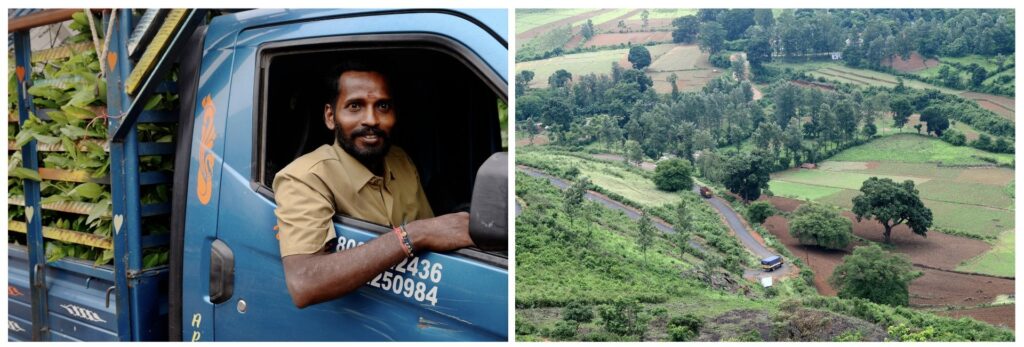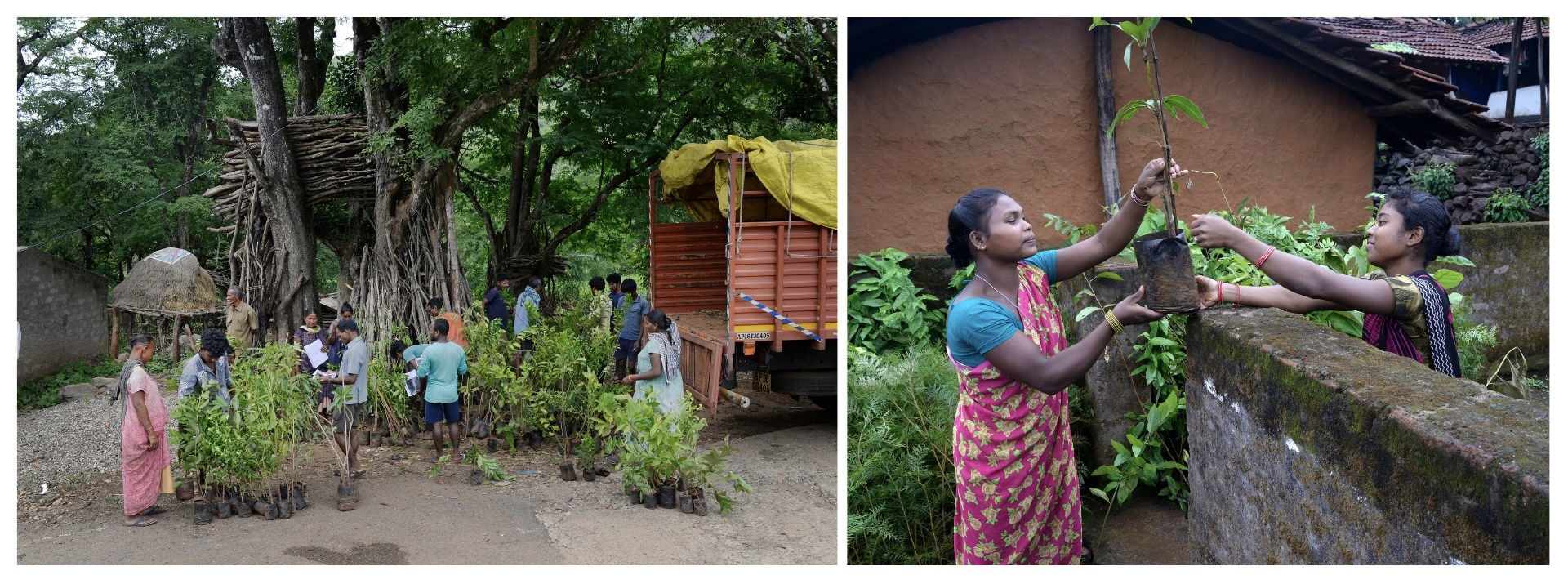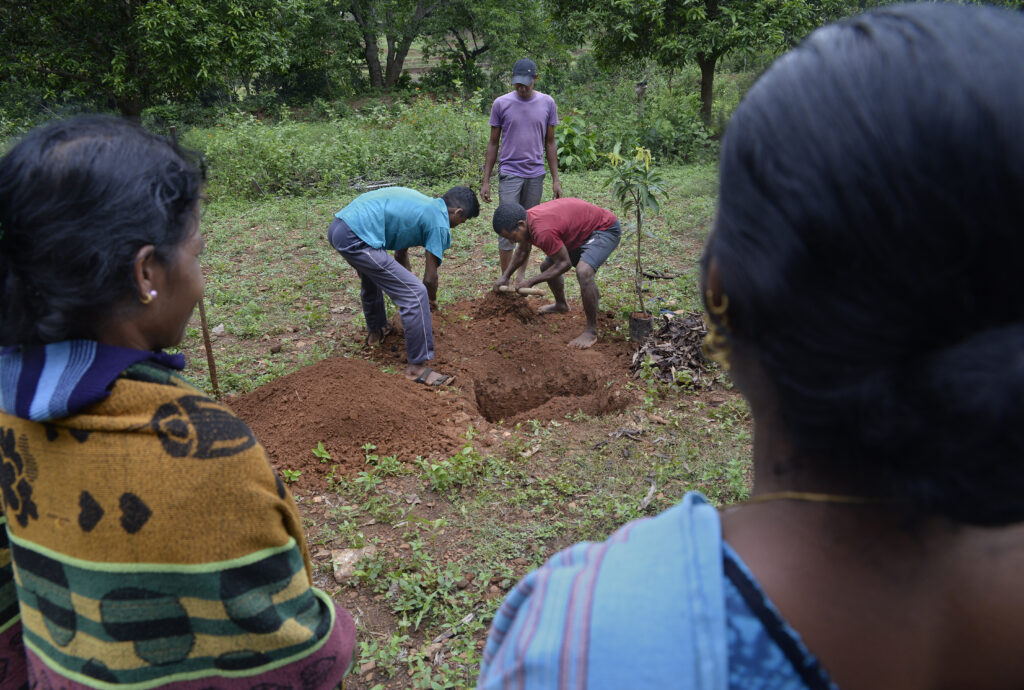“6.4 million saplings transported up hills to remote tribal villages, distributed to farmers in customised species combinations, in just two months! How is that even possible!?”
We hear that a lot. The sheer scale of our annual sapling drive comes as a surprise to many. And to be fair, it does sound near impossible! But the sapling drive is one of our most important (and indeed challenging) operations of the year. Every monsoon, across June and July, our teams on the ground collaborate with over 40 nursery vendors, thousands of truck drivers, and tens of thousands of farmers to pull off this massive logistical exercise.
We commenced tree planting activities in the Araku region in 2010, and by 2012, we were planting over 1 million saplings every year. Ever since, we have been learning from and refining the art of moving millions of saplings across the pristine, mountainous landscapes of Araku Valley. As many of you know, this region is home to many of our smallholding farmer partners, who live across hundreds of remote villages. The roads to each village can be steep, narrow, and sometimes vanish into a muddy slope after a downpour. But we’ve never let the terrain stop us. Recently, we crossed a milestone we are very proud of: delivering over 50 million saplings since our first sapling drives began. To commemorate this feat and congratulate our teams and farmers, we want to share why we do this every year and how we do it, against all odds.
To begin the story, it is important to mention that our organic-regenerative model applies an agroforestry approach. Agroforestry is the practice of growing fruit and timber trees alongside food crops to create a more productive, resilient ecosystem. Essentially, it recreates the true conditions of nature: diversity, abundance, and cooperation. Agriculture practiced as agroforestry recreates food forests, and the presence of trees provides a wide range of benefits to the food production ecosystem.
To list but a few, all trees – whether fruit, timber, or medicinal varieties – act as windbreakers and provide habitats for birds and small animals. Their canopies shield crops and soils below from harsh sun and heat, while their fallen leaves form a natural layer of mulch upon the soil which keeps it covered, cool, and better able to retain moisture. Tree roots penetrate deep into the soil, creating channels for rain water to permeate into and replenish groundwater reserves. Those same roots attract a hidden world of diverse microorganisms that supply the tree with essential nutrients in a mutually beneficial relationship. And of course, diverse trees directly support farmer families: especially fruit trees which provide short-term, seasonal cash flows and nutritional replenishment, or timber trees which if nurtured over the long term, serve like a fixed deposit to be “withdrawn” in case there are any times of financial hardship.
When these benefits are added to those brought by crop rotations and harvests, smallholding farms become both more productive and more profitable. And all this occurs without damaging the environment in any way. It’s actually the opposite, as by growing a diverse range of crops and trees to thrive and yield side-by-side, farmers can feed their families well, earn steady incomes, and help to restore sustainable and localised food-forest economies. It is for these reasons that we are so committed to our annual sapling drives, and why we dream of scaling them up in the future, to spread agroforestry not just in Araku, but in other regions of India as well.

To give an idea of scale and complexity of these drives: in the 2024 monsoon, trucks of four different sizes (3, 4, 6, and 8 tonne carrying capacity) collected 6.4 million saplings of 14 different species from the nurseries of Kadiyam in East Godavari District—a region famous for its horticultural expertise. Each truck was loaded with saplings grown to our exact specifications: at least three feet tall, packed in the right polybags with the right soil mix, as per the prescribed loading sequence. And yes—the order of loading the saplings onto trucks is very important! Most especially for trucks delivering saplings to multiple villages, as the saplings to be unpacked at the first village should be loaded last, while the saplings to be unpacked at the last village are to be loaded first. If this order was wrong, we’d have been forced to unpack and reload the entire truck—a risky and time-consuming process that could have damaged the delicate saplings.
The trucks were loaded at night, around 9pm, before beginning the 250 km climb into the Eastern Ghats, arriving at our Araku basepoint where our field teams meet them around 4am the next morning! Members of these teams then hopped into the trucks with the drivers to navigate them to the correct village or series of villages. They oversaw the unloading process and ensuring that the entire order of saplings is delivered to the village for residing farmers to collect, carry home, and begin planting.

You might be wondering why we would choose to do all this during the monsoon season? When the roads are muddy, slippery, and prone to landslides, which makes delivery all the more challenging? The reason: there are no irrigation facilities in the Araku region. Monsoon rainfall is the only water the land receives. It acts as nature’s irrigation system, soaking the soil and giving each sapling the moisture it needs to settle and recover from the shock of travel and transplanting. This steady supply of water also softens the soil, which helps the delicate roots of saplings anchor themselves properly to begin absorbing nutrients, which significantly increases the saplings’ chances of survival.
A softer soil also makes digging easier! This is no small blessing when many farmers, who receive over six hundred saplings, are digging the equivalent number of pits—each one about two feet wide and two feet deep. Doing this in dry, hardened soil would be exhausting. So the rain, despite seeming a hazard, is actually our ally: softening the earth for the saplings whilst turning a back-breaking task for the farmer into a manageable one. Given the sheer number of saplings delivered and planted and the logistical and physical effort involved, we believe this is one of the largest and most difficult rain-fed planting operations of its kind.

This is why every step of our sapling drive—from nursery pick-up and intricate loading sequences to thorough quality checks and coordinated deliveries—is so critical to get right. Along the way, there are always trucks that break down, roads blocked by landslides, saplings damaged en route, and last-minute requests from farmers to delay deliveries. But our teams work around the clock to solve these problems as they arise, keeping the supply and delivery chain moving no matter what.
It is certainly not easy. But every season, our field teams and farmer partners show up with grit, determination, and a shared commitment to delivering and planting millions of trees. Together, we move each sapling across mountains and muddy roads, to hundreds of villages, and finally into the soil—where they take root, enrich the land, and grow into a part of a thriving agroforestry ecosystem.




